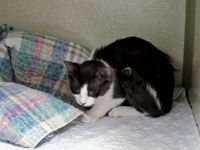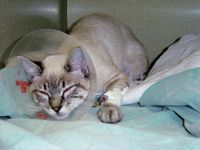CVC 2008 Highlights: Behaviors suggestive of postoperative pain in cats
Our understanding and treatment of pain in cats has lagged behind that in dogs.
In the United States, pet cats outnumber pet dogs, yet our understanding and treatment of pain in cats has lagged behind that in dogs. Veterinarians consider surgical procedures in dogs and cats to be equally painful, but we treat cats perioperatively for pain less often than we do dogs.1 This undertreatment of pain results, in part, from the difficulty in recognizing and assessing pain in cats.
Various pain-scoring systems have been used to assess postoperative pain. These systems measure physiologic data (objective) or evaluate behavior (subjective) or do both. Algometers and pressure platform gait analysis are objective pain measuring tools, whereas the visual analog scale (VAS) is an example of a widely used subjective scoring system. The basic VAS used for assessing pain consists of a continuous line anchored at either end with a description of the scale's limits. For example, "no pain" would be at one end of the scale and "severe pain" would be at the other. The observer places a mark on the line that he or she thinks correlates to the animal's degree of pain. This mark is later converted to a number by measuring the distance of the mark from zero.
Each practice should choose or design a scoring system that meets its own specific needs; finding this system may require some trial and error. The system chosen should be user-friendly for veterinarians and support staff. It should also be an integral part of an animal's postoperative evaluation. That is, after checking temperature, pulse, and respiration, you should assess the patient for pain—the fourth vital sign.
The scale you choose should include both noninteractive and interactive components and should rely heavily on changes in behavior. For example, with the dynamic and interactive visual analog scale (DIVAS)—an extension of the VAS—animals are first observed undisturbed from a distance and are then approached, handled, and encouraged to walk or move around. Finally, the surgical incision and surrounding area are palpated, and an overall assessment of pain is made.
BEHAVIORS CORRELATED WITH PAIN
To assess postoperative pain, evaluate a cat's posture and orientation and position in the cage, facial expression, loss of normal behaviors, and response to palpation.
Posture
A cat that adopts a hunched posture with its head hung low, sits quietly and seeks no attention, or resents being handled is likely experiencing pain (Figure 1). In one of the few studies in which detailed behavioral ethograms (quantitative descriptions of animal behavior) have been constructed, a hunched or tucked up posture appears to be correlated with acute pain in cats after abdominal surgery.2 This observation has been corroborated by preliminary work at the University of Glasgow (Robertson SA, College of Veterinary Medicine, University of Florida. Unpublished data, 2007).

1. After surgery, this cat's posture-hunched with a lowered head-indicates pain.
Orientation in cage
A cat experiencing postoperative pain will often sit in the back of its cage. This subtle sign of pain will remain unrecognized if the caregiver expects to see more active signs of pain, such as pacing, agitation, or vocalizing.
Facial expression
A head-down posture, with eyelids half-closed and eyes held in a slanted position may correlate with pain (Figure 2).

2. This cat's posture and facial expression are consistent with abdominal pain.
Loss of normal behaviors
The absence of normal behaviors in a specific patient (e.g. grooming or playing with string) should prompt you to assess that patient for pain. Many cats that are fearful or stressed will stay at the back of their cages and hunch themselves up, but if you observe these cats before and after surgery, you can detect subtle changes. For example, if pain relief is inadequate, a cat may be even more hunched than before. And instead of just being at the back of the cage, it may actively try to hide under things (Figure 3), and its facial expression will be different from that before surgery.

3. A friendly cat that played at the front of its cage before surgery hides afterward.
It is important to assess patients before and after surgery. Each cat is unique, and some will have altered behavior due to stress. The trick is to pick up small changes for that specific cat that can be attributed to pain. However, stress and fear are aversive emotions that can worsen pain, so they should not be dismissed. Instead, give some thought as to how to also relieve stress and fear, such as by providing a cat-only area, boxes for cats to hide in, and favorite toys and blankets from home or by using a synthetic feline pheromone (Feliway—Ceva Santé Animale).
Response to palpation
Wound palpation is an important component of pain assessment; you should be able to apply gentle pressure to a surgical wound without a cat's flinching or turning to bite (Figure 4). One of the many commonly reported problems after onychectomy is excessive licking and chewing of the feet.3 Cats will often shake their paws and try to bite at their feet if bandages are placed on onychectomy wounds. These behaviors could indicate postoperative pain, pain from an incorrectly placed bandage, or a dislike of the bandage, so it is important to differentiate among these.

4. Palpating a bone graft site to assess for pain.
HOW OFTEN SHOULD PAIN BE ASSESSED?
The patient's health status, the extent of the surgery or injuries, and the anticipated duration of effect of the analgesic drugs administered determine the frequency and interval of evaluations. If a cat, for example, is resting comfortably (normal posture and facial expression) after postoperative buprenorphine administration, it may not need to be reevaluated for two to four hours. Allow animals to sleep after analgesic therapy. Vital signs can often be checked without unduly disturbing a sleeping animal. In general, do not wake an animal to check its pain status; however, the patient should still receive scheduled analgesics.
Continuous, undisturbed observations coupled with periodic interactive observations (e.g. palpating the wound) are likely to provide more information than occasionally observing the animal through the cage door. Unfortunately, continuous observations are not practical for most clinical situations. But the more frequent the observations, the more likely that subtle signs of pain will be detected.
Sheilah A. Robertson, BVMS (Hons), PhD, DACVA, DECVA, CVA, MRCVS
Section of Anesthesia and Pain Management
Department of Large Animal Clinical Sciences
College of Veterinary Medicine
University of Florida
Gainesville, FL 32610
This highlight was selected from a lecture Dr. Robertson gave as part of the International Veterinary Academy of Pain Management tract at the 2008 CVC Central.
REFERENCES
1. Lascelles B, Capner C, Waterman-Pearson AE. A survey of current British veterinary attitudes to peri-operative analgesia for cats and small mammals. Vet Rec 1999;145:601-604.
2. Waran N, Best L, Williams V, et al. A preliminary study of behaviour-based indicators of pain in cats. Anim Welfare 2007; 16(S):105-108.
3. Patronek GJ, Assessment of claims of short- and long-term complications associated with onychectomy in cats. J Am Vet Med Assoc 2001;219(7):932-937.